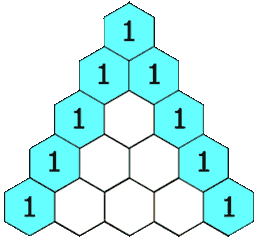Topic
- Array
Description
https://leetcode.com/problems/pascals-triangle-ii/
Given an integer rowIndex, return the rowIndexth row of the Pascal’s triangle.
Notice that the row index starts from 0.

In Pascal’s triangle, each number is the sum of the two numbers directly above it.
Follow up:
Could you optimize your algorithm to use only O(k) extra space?
Example 1:
Input: rowIndex = 3
Output: [1,3,3,1]
Example 2:
Input: rowIndex = 0
Output: [1]
Example 3:
Input: rowIndex = 1
Output: [1,1]
Constraints:
- 0 <= rowIndex <= 33
Analysis
略
Submission
import java.util.LinkedList;
import java.util.List;public class PascalsTriangleII {public List<Integer> getRow(int rowIndex) {List<Integer> result = new LinkedList<Integer>();if(rowIndex < 0) return result;for(int i = 0; i <= rowIndex; i++) {result.add(0, 1);for(int j = 1 ; j < result.size() - 1; j++) result.set(j, result.get(j) + result.get(j + 1));}return result;}
}Test
import static org.junit.Assert.*;
import static org.hamcrest.CoreMatchers.*;import java.util.ArrayList;
import java.util.Arrays;import org.junit.Test;public class PascalsTriangleIITest {@Testpublic void test() {PascalsTriangleII obj = new PascalsTriangleII();assertThat(obj.getRow(3), is(new ArrayList<>(Arrays.asList(1, 3, 3, 1))));assertThat(obj.getRow(0), is(new ArrayList<>(Arrays.asList(1))));assertThat(obj.getRow(1), is(new ArrayList<>(Arrays.asList(1, 1))));assertThat(obj.getRow(4), is(new ArrayList<>(Arrays.asList(1, 4, 6, 4, 1))));}
}



)




 的解决办法)


方法)







